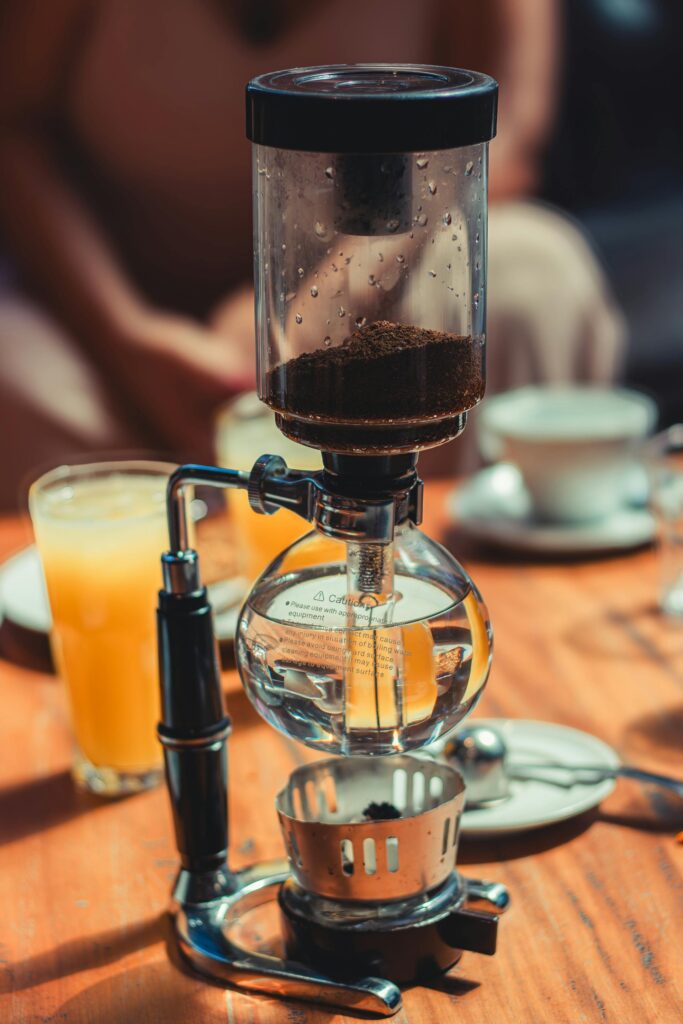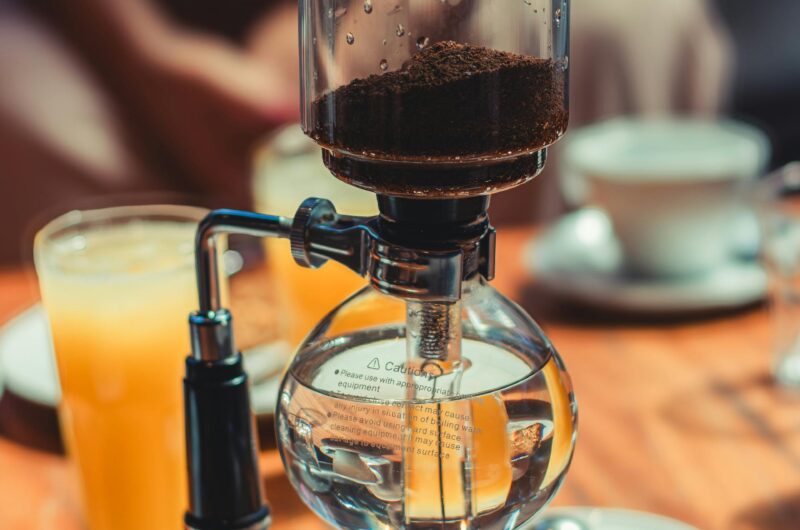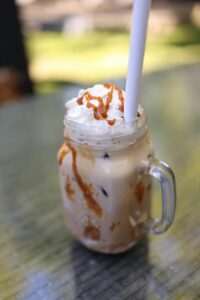It looks like something straight out of a science lab with two glass chambers, bubbling water, rising vapor, and a dramatic whoosh as your coffee comes to life.
But this isn’t just coffee with flair. It’s siphon brewing, where science and flavor meet in the most theatrical way possible.
Yes, it’s mesmerizing. But beneath the show is a precise method that extracts rich, clean flavor like few others can.
Let’s peek behind the curtain and explore the science that makes this coffee magic happen.
What Is Siphon Coffee Brewing?
Siphon brewing, also called vacuum brewing, is a coffee method that uses two stacked glass chambers and a bit of scientific magic to brew your cup.
It may look like something out of a chemistry lab, but it’s been around since the 1830s, with origins in both Europe and Japan.
The idea is simple but brilliant: heat in the bottom chamber forces water upward, where it meets the coffee grounds in the top.
After a short brew time, the heat is removed, creating a vacuum that pulls the brewed coffee back down through a filter.
The result? A show-stopping process and a cup that’s smooth, rich, and impressively clean. What makes it stand out isn’t just the visual appeal—though that certainly draws a crowd. It’s immersive.
You’re involved in every step, from watching water rise like a lava lamp to the satisfying final pour. Plus, the full immersion brewing style brings out layered flavors with surprising clarity.
It’s part science experiment, part sensory ritual, and all about brewing with intention.
Equipment Breakdown
Essential Gear
- Upper and lower glass chambers – These are the heart of the siphon. The lower chamber holds the water; the upper one holds the coffee grounds. They’re usually made of heatproof borosilicate glass—beautiful, but delicate.
- Filter – Typically cloth (for a clean cup with body) or metal (for a bolder brew). It sits between the chambers and plays the critical role of keeping grounds out of your final cup.
- Heat source – Butane burner, halogen lamp, or alcohol burner. Each offers steady heat, but some are more adjustable than others. A consistent flame is key.
- Stirrer or paddle – Used to mix the coffee grounds gently. Usually made of bamboo, glass, or plastic to avoid damaging the chambers.
Optional but Helpful Tools
- Coffee scale – Accuracy matters in siphon brewing. A scale ensures consistent ratios of water to coffee every time.
- Timer – Timing your brew helps avoid over-extraction. A simple kitchen timer or phone works fine.
Note: Siphon setups are fragile but elegant—more art gallery than garage tool. Handle with care, clean gently, and store safely. One bump and it’s heartbreak (and probably glass shards).
How It Works: The Science of Siphon Brewing
Siphon coffee isn’t just about flair, but it’s a clever dance between physics and chemistry. Let’s break it down, one bubbling chamber at a time.
The Physics
It all starts with heat. As the burner heats the water in the lower chamber, vapor pressure builds.
This pressure increases as the water reaches near-boiling temperatures, eventually forcing the hot water to rise through a small tube and into the upper chamber where the coffee grounds wait.
Think of it like a mini geyser—science in action, but less dangerous and more delicious. Once the water is in the top chamber, you stir in the coffee and let it brew.
Here’s where the magic happens: when you remove the heat, the lower chamber begins to cool. As it does, a vacuum is created.
That vacuum sucks the brewed coffee back down through the filter, leaving the grounds behind in the upper chamber. No plungers, no levers, but just pure atmospheric pressure doing the heavy lifting.
The Chemistry
Temperature plays a huge role in the flavor you get. Siphon brewing naturally keeps the water between 91–96°C, which is the sweet spot for extracting coffee.
Because the water fully immerses the grounds, every bit of coffee gets evenly saturated. There’s no dry clumps, no uneven pours—just consistent extraction.
And since there’s very little agitation (just a gentle stir), you avoid over-extracting bitter compounds.
The result? A cup that’s clear, vibrant, and full of layered notes.
Why It Matters
Siphon brewing gives you an unusual level of control. The temperature stays stable. The brewing time is precise. And thanks to the filter, you get a coffee with low sediment and high clarity.
It’s like French press and pour-over had a clean, flavorful baby.
The physics of vapor pressure and vacuum force don’t just make for good drama because they’re essential for pulling out the best flavors while keeping grit and bitterness at bay.
So yes, it looks fancy. But behind the glass and bubbles, there’s real science brewing your cup to perfection.
Step-by-Step Brewing Guide
Brewing siphon coffee is equal parts art and science. The process looks theatrical, but once you understand the flow, it’s surprisingly simple.
Here’s how to turn that bubbling contraption into a perfect cup.
1. Add Water to the Bottom Chamber
Fill the lower chamber with fresh, filtered water. Don’t skimp here because bad water equals bad coffee. Aim for the amount you plan to brew, typically 300–400 ml for two cups.
2. Apply Heat and Wait for the Water to Rise
Place the chamber over your heat source and watch closely. As the water warms, vapor pressure pushes it up into the upper chamber.
It feels like watching a science fair project, but the kind that ends with caffeine.
3. Add Coffee Grounds
Once the water is fully in the top chamber, add your coffee grounds (medium grind works best). Too fine, and it’ll clog the filter; too coarse, and you’ll under-extract.
A ratio of about 1 gram of coffee per 15 grams of water is a good starting point.
4. Stir Gently and Brew for 45–60 Seconds
Use a bamboo or plastic stirrer to mix lightly but just enough to saturate the grounds evenly.
Don’t go wild here; over-stirring can lead to bitterness. Let it brew for around one minute while maintaining steady heat.
5. Remove Heat and Watch the Coffee Descend
Here comes the showstopper moment. Once you pull away the heat, the lower chamber cools and creates a vacuum.
The brewed coffee is pulled down through the filter in a smooth, almost hypnotic swirl, leaving the used grounds behind. It’s a little coffee magic right before your eyes.
6. Serve Immediately
Detach the top chamber, give your coffee a quick swirl, and serve. Siphon coffee is best enjoyed fresh, so don’t let it sit too long, or it’ll lose that delicate flavor balance.
Tips for Better Results
- Pre-wet your filter to remove any residual flavors and ensure a clean brew.
- Don’t over-stir—gentle mixing keeps bitterness at bay.
- Use a timer for consistent results every time.
- Dial in your grind and dose—small tweaks make big flavor differences.
Flavor Profile: What Makes Siphon Coffee Unique
Siphon coffee stands out for its clean, aromatic, and deeply nuanced flavor—like someone turned up the brightness on your beans.
It captures the clarity of a pour-over but with more body, and it brings out delicate floral, fruity, or chocolatey notes that might get buried in other brewing methods.
Compared to a French press, siphon coffee has far less grit and muddiness, so you’re not chewing your way through sludge. It’s lighter on the tongue but still full of character.
Against pour-over, it holds more depth and smoothness, thanks to its full immersion and stable brewing temperature.
And while espresso hits like a flavor punch to the jaw—intense and concentrated—siphon offers a more balanced, elegant sip.
It’s the kind of brew that invites you to slow down and actually taste what’s in your cup. That’s why coffee geeks love it: you get complex layers of flavor without sacrificing clarity.
Pros & Cons of Siphon Brewing
Siphon brewing isn’t your everyday grab-and-go coffee method, but that’s exactly why it shines. Let’s weigh the highs and lows so you know if it’s worth adding to your coffee ritual.
Pros
- Visually stunning – It’s a showstopper. Watching the water rise, coffee swirl, and brew descend feels like brewing meets Broadway.
- Excellent flavor clarity – You get a clean, balanced cup that highlights subtle notes most methods might blur.
- Impress guests or customers – Whether at home or in a café, siphon brewing grabs attention. It’s conversation-starting coffee.
- Fun for science/tech lovers – If you enjoy precision, tinkering, and gear with a purpose, this method checks every box.
Cons
- Time-consuming – It’s not your “I’m late for work” brew. This method takes patience, prep, and cleanup.
- Fragile equipment – Glass chambers can break with one wrong move. Handle with care or keep a backup.
- Learning curve – Between temperature control, timing, and technique, expect some trial and error early on.
- Not ideal for large batches – Brewing more than two cups can be a chore. It’s built for quality, not quantity.
Common Mistakes to Avoid
Here’s what to watch out for so your brew doesn’t go from wow to meh.
Overheating Water = Bitterness
If you crank the heat too high or let the water boil aggressively, you risk burning the coffee or extracting harsh, bitter compounds. The sweet spot for brewing is between 91–96°C.
Keep an eye on the water—gentle bubbles, not a rolling boil. Think simmer, not volcano.
Not Creating a Proper Seal
If the top and bottom chambers don’t seal well, the pressure won’t build properly. That means the water might not rise—or worse, it bubbles awkwardly without fully transferring.
Make sure the two chambers are fitted snugly and the filter is secured tightly with the chain properly anchored at the bottom.
Using the Wrong Grind Size
Grind too fine and your filter clogs, leaving your coffee stuck in the upper chamber like a failed science project. Too coarse, and you’ll end up with weak, under-extracted coffee.
A medium grind—similar to sand—is your best bet. Adjust slightly finer or coarser depending on your taste and timing.
Not Cleaning the Cloth Filter Thoroughly
Cloth filters give great clarity and mouthfeel, but they’re a pain if you don’t clean them well. Old coffee oils and residue build up fast and ruin your flavor.
Rinse it thoroughly after each use, store it in water in the fridge, and boil it occasionally to refresh. If it starts smelling funky, it’s time to swap it out.
Is It Worth the Hype?
Siphon brewing definitely isn’t for everyone, but for the right kind of coffee lover, it’s pure joy.
If you’re a home barista who enjoys the craft, loves experimenting, or simply wants to elevate your weekend ritual, it’s 100% worth it.
It also shines in café settings where showmanship matters because nothing grabs attention like a bubbling glass contraption brewing coffee before your eyes.
Coffee events, tastings, or even date nights? Perfect time to bring out the siphon. But if your mornings are a blur of alarms, emails, and quick exits, this method will likely feel like too much.
The same goes for travel setups or tight budgets because it’s not the most convenient or durable choice.
Bottom line? If you enjoy both the art and the science of coffee and don’t mind slowing down a bit, the siphon is a fun, flavorful, and visually rewarding experience that lives up to the hype.
Final Words
Siphon brewing is where coffee meets curiosity—part theater, part science, all flavor. It’s dramatic, precise, and unbelievably satisfying to watch and taste.
This isn’t just brewing; it’s performance art in a glass. So grab a siphon, fire up the burner, and try it this weekend. You’ll see (and taste) why coffee lovers call it pure magic in motion.
FAQs
Can I use a regular stove?
Not really. Most siphon setups need a direct, focused heat source like a butane burner or halogen lamp.
A regular kitchen stove doesn’t give you enough control, and open flames plus glassware is a risky combo.
What grind size is best?
Medium grind, similar to sand. Too fine, and your filter clogs. Too coarse, and your brew turns out weak. Start in the middle and adjust based on taste and brew time.
Does it affect caffeine content?
Slightly. Because of the full immersion and brew time, siphon coffee usually has a bit more caffeine than pour-over, but less than espresso. It’s balanced, not a rocket boost.
How long does a siphon take from start to finish?
Around 6 to 10 minutes total. That includes heating, brewing, and cleanup. Definitely not your weekday rush brew but perfect for slow, intentional coffee moments.
Can I use a paper filter instead of a cloth?
Some models allow it, but cloth is the classic choice for good reason. It gives clarity and body. Paper can work in a pinch, but it may strip away some of the flavor complexity.
Vacuum (Siphon) Coffee Brewing: The Science Behind the Show
Course: Brewing GuidesDifficulty: Intermediate2
cups5
minutes6
minutes11
minutesA visually stunning brew method that uses vapor pressure and vacuum force to create a clean, aromatic, and balanced cup of coffee.
Ingredients
300 ml filtered water
20 g medium-ground coffee (about sand texture)
Directions
- Fill the lower siphon chamber with water.
- Attach the upper chamber with the filter in place.
- Apply heat and let water rise into the top chamber.
- Add coffee grounds and stir gently.
- Let it brew for 45–60 seconds while maintaining heat.
- Remove heat and allow coffee to draw down into the lower chamber.
- Detach the top chamber and serve immediately.
Notes
- Pre-wet the cloth filter before brewing.
- Avoid over-stirring to prevent bitterness.
- Adjust grind size and brew time to taste.
- Clean the filter thoroughly after each use to preserve flavor.




